Wellington’s iconic red cable car is the best way to reach Kelburn Lookout for one of the best views in the city. Photo by Liz Campbell
By Liz Campbell
Perched at the edge of a precipitate drop, my first thought would NOT be, ‘Wouldn’t it be fun to dive off here?’ But, in Queenstown, New Zealand thousands of tourists don’t agree.
The logo of AJ Hackett, the first commercial bungee jumping facility in the world, is Live More, Fear Less, and visitors have taken this message to heart. This picturesque town’s location on the shores of Lake Wakatipu, surrounded by the jagged peaks of The Remarkables, has made it a mecca for skiers, paragliders, skydivers, zipliners, and of course, bungee jumpers, all taking advantage of those vertiginous slopes. For the rest of us, it’s enough to simply marvel at the vistas of New Zealand’s Southern Alps.
New Zealand’s Norway
Born of volcanoes millions of years ago, the striking landscape of New Zealand’s South Island was further shaped by earthquakes. Here, snow-capped peaks charge skyward leaving calm, green valleys to the sheep grazing peacefully below. Around the coastline, deep water channels have carved a maze of inlets through rocky summits, creating spectacular fjords. Indeed, author Rudyard Kipling suggested that Milford Sound, part of Fiordland, should be designated the Eighth Wonder of the World.
The country’s North Island, where 77 percent of the population lives, is quite different. Its tour de force is a wide, central geothermal zone where the earth’s crust can be as little as 12 km (7.5 mi) deep. With so much heat close to the surface, the terrain of Rotorua Lakes District is very dramatic. Mud pools, like pots of bubbling porridge, are scattered throughout the region. Geysers send bursts of scorching water into the air. And scalding lagoons are shrouded in foggy vapor.

Hot steam rises from a geothermal spring beside a Maori house near Rotorua. Photo by Liz Campbell
The city of Rotorua, straddling the shores of its eponymous lake, may be modern, but the geothermal activity is evident. In Kuirau Park, just 200m (about 200 yards) from the city center, swirling clouds of vapor rise theatrically from cracks in the earth. The park’s walkways are fenced, and warnings caution visitors to keep within these designated areas as the surface can give way, dropping one into blisteringly hot water. The stronger sulphur scent here adds to the drama. Cue Macbeth’s witches.
A group of people are sitting with their feet in a small pool of comfortably hot water. I join them, and meet Charlie Johnson, a garrulous local who tells me, “Your feet will thank you for this.” He explains that these springs of water, coming up from beneath the earth, are filled with minerals. “Smell that? It’s not coming from factories; it’s all natural,” he says taking a deep sniff of the sulphur-laden air. “That’s Mother Earth farting!”
Meet the Māoris
Down the road at Te Puia, Mother Earth offers more than flatulence. The Pōhutu Geyser here spouts a giant plume of water and steam to a height of 30m (100 feet) as many as 20 times a day. All that hot water and steam is quite awesome.

The Pohutu Geyser erupts with a giant plume of steaming water. Photo by Liz Campbell
Te Puia is home to the New Zealand Māori Arts and Crafts Institute where indigenous artists are learning centuries-old crafts and carving techniques from skilled elders. This area is sacred to the Māori people, descendants of the first Polynesians who discovered these islands in the 13th century.
Those first human inhabitants arrived in large voyaging canoes and named it Aotearoa, ‘the land of the long white cloud’. This is still its Māori name. Its European name was bestowed several centuries later in 1642, by Dutchman Abel Tasman. New Zealand maintained its name after Captain James Cook claimed it for Britain more than 125 years later. It wasn’t long before the first European immigrants began to arrive.

Students at Ta Puia learn tradition carving designs and techniques. Photo by Liz Campbell
Sailing south with Heritage Expeditions along New Zealand’s east coast, the results of this colonization are evident. With a resident historian and several naturalists, this expedition cruise offers an opportunity to get up close to both New Zealand’s natural world and the creativity of its human inhabitants. We visit towns like Napier, rebuilt in the 1930s after an earthquake, in the elegant European Art Deco style. But nearby, at Cape Kidnappers Gannet colony, even brilliant architecture is eclipsed by the opportunity to get close to hundreds of these raucous seabirds and their chicks.
Land of Many Cultures
The Heritage Adventurer’s voyage south brings us to many pretty towns, each reflecting the nationality of the settlers who built them. Akaroa might have a Māori name but the fluttering tricolors, and street names like Rue de Melmanche, Rue Balguerie and Rue Benoit, are clues to the nationality of its first settlers who arrived on the Comte de Paris in 1840. Small Akaroa Dolphins greet us as we sail into the harbor, and ashore, real French patisserie scents the air.
Further south, it’s easy to see Dunedin was founded by Scots. Apart from its name – Gaelic for Edinburgh – the prominent statue of Robbie Burns and the distinctive Scottish architecture give away its origins. While the city is much more cosmopolitan these days, you’ll still find the occasional bagpiper, as well as whiskey and haggis on pub menus.
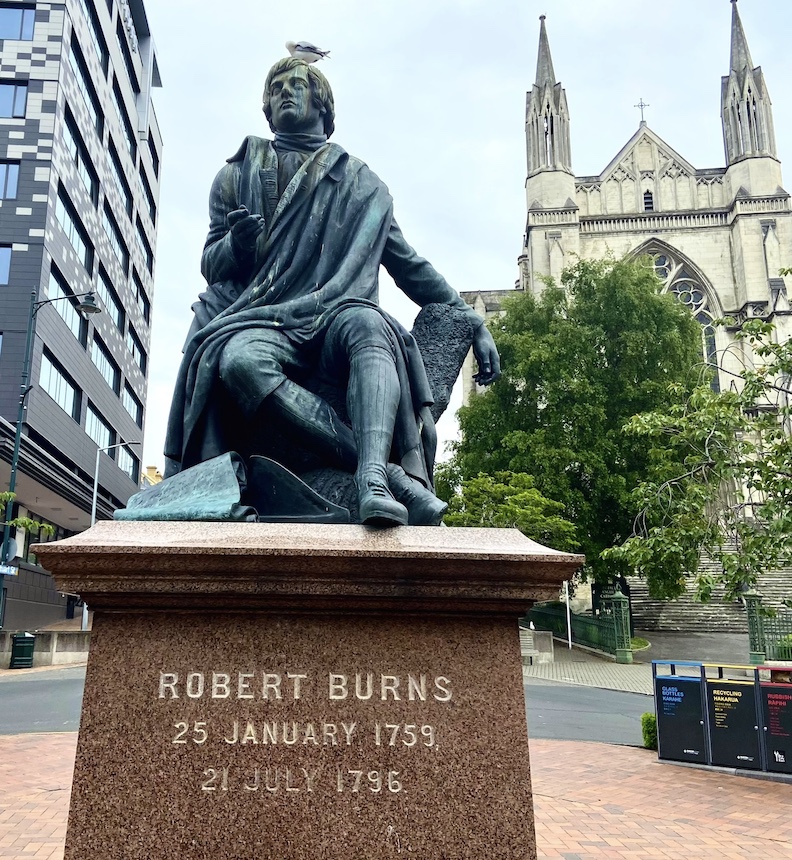
Scottish port Robert Burns occupies a prominent location in downtown Dunedia, NZ. Photo by Liz Campbell
But our expedition also highlights the challenges this immigration has imposed on an ecosystem unused to the competition posed by European plants and animals. Some of these were imported by settlers, others, like rats, cats, stoats, and even plant seeds, were unforeseen hitchhikers. These played havoc with New Zealand’s native species; many were completely wiped out.
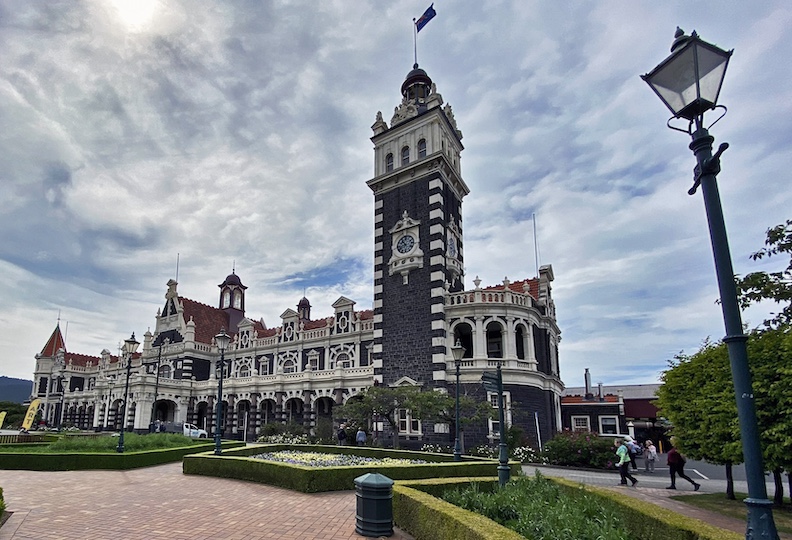
Dunedin’s stone railway station is one of the most photographed buildings in New Zealand. Photo by Liz Campbell
Keep Out!!!
The country responded with a unique solution – predator-free zones. In the capital city of Wellington, a one square mile (252 hectares) pest-free wilderness is surrounded by a purpose-built 8.6-kilometer perimeter fence that descends deep into the ground. The aim is to keep out introduced mammalian predators. This is Zealandia, and within its boundaries, all traces of invasive pests have been removed. Instead, rare and endangered birds – like the little spotted kiwi, the saddleback, stitchbirds, and kaka – have found a safe home. Here, the tuatara, a rare lizard and the last survivor of an order of reptiles that lived in the age of the dinosaurs, has been brought back from the brink of complete extinction.
But this wilderness is just a small part of the efforts made by New Zealand. The rescue of native species went further, designating whole islands such as Ulva and Motuara as predator-free zones, deliberately removing all non-native plants and animals, to ensure that indigenous species might have a chance to thrive. And thrive they do.
When the Heritage Adventurer sails into Queen Charlotte Sound, we drop anchor in Ship Cove (named by Captain Cook). Here we board zodiacs to explore Motuara Island. It was here, on January 31, 1770, that Cook and his officers hoisted a British flag and claimed Queen Charlotte Sound for George III.
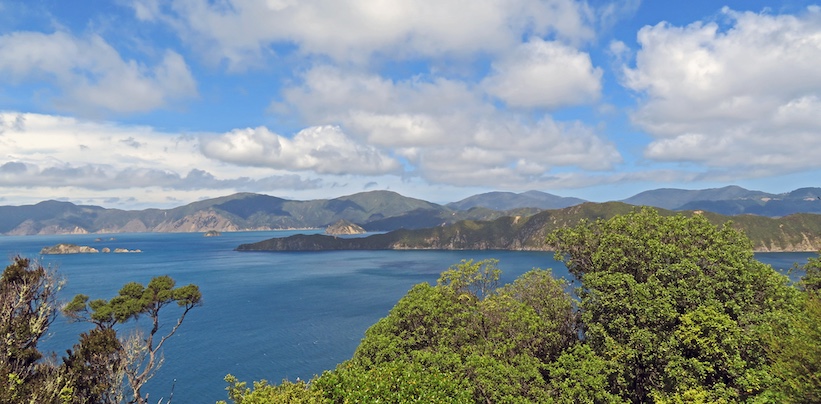
Captain James Cook would have seen this view of Ship Cove in Queen Charlotte Sound from Motuara Island. Today the island is a predator-free zone. Photo by Liz Campbell
Rod Morris, one of our ship’s resident naturalists, leads our exploration of the island. Spotting birds like fantails, saddlebacks, a noisy kaka, and several weka, a close relation of the kiwi. He’s on the lookout for a kākāpō, a flightless bird that looks like a cross between a parrot and an owl. Forty years ago, Morris was part of the team of biologists who located and rescued the last remnants of this species. “Volunteers are still helping to keep them safe,” Morris explained. “Dozens of them mind the nests during kākāpō breeding season.”
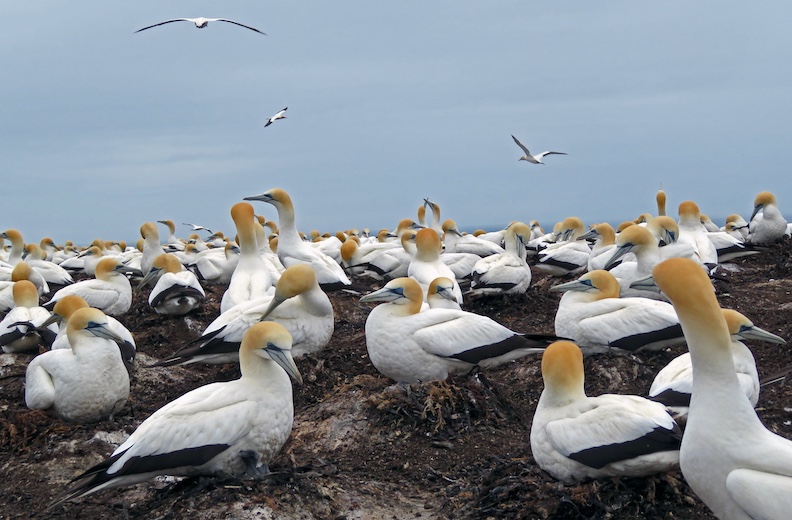
A visit to Cape Kidnappers gannet colony with the Heritage Voyager is an opportunity to get up close and personal with these remarkable, raucous birds. Photo by Liz Campbell
Protecting the Penguins
When we sail into Fiordland, our other keen-eyed naturalist, Sarah Tranmer, spots a Fiordland Crested Penguin and our zodiac approaches the rocks where a pair is standing sentry over their domain. “The population of these small penguins is threatened,” she explains. “We were lucky to see them.” Exploring with specialists whose knowledge and understanding of this country’s fauna and flora is extensive, provides a special dimension to being a tourist in this country.
Indeed, being a tourist here undoubtedly offers many rare experiences. New Zealand isn’t large but its geology has created a landscape that is unusual and even bizarre. Small wonder then, that it was a Kiwi, Peter Jackson, who was inspired to bring Middle Earth to life in this, his native land.
And Hobbits, Too
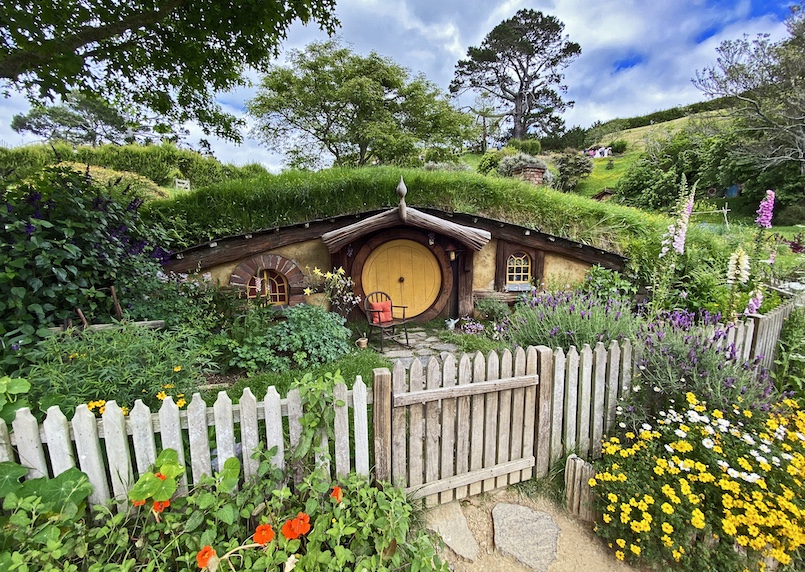
The houses in Hobbiton, which were used as external sets for The Hobbit and the Lord of the Rings movies, might be human-sized or Hobbit-sized. The clue in this one is the size of the tall, purple Delphiniums which are taller than the door. After strolling around the village stop for a ginger beer before heading back to Auckland. Photo by Liz Campbell
In New Zealand, one can visit the Lord of the Rings movie set at Hobbiton, or meet extraordinary native creatures like the tuatara which walked the earth with dinosaurs. One can visit villages like Whakarewarewa or the Te Papa National Gallery in Wellington to discover more about Māori culture. Or one can leap into the magic of soaring mountains on the end of a bungee cord, on a zipline, or on skis. There’s much to discover in this dramatic and unique land.![]()
Elizabeth “Liz” Campbell is a Toronto-based travel writer whose most recent stories for EWNS looked at Cairns and the Great Barrier Reef and Norway’s Sunnmøre Region.

